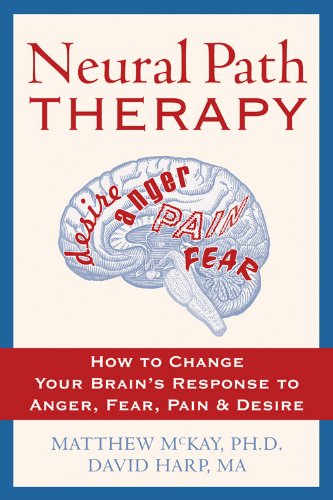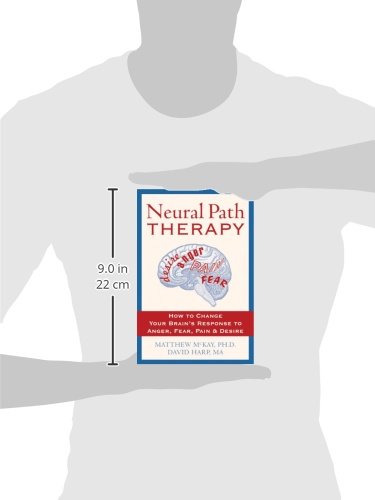Customer Services
Copyright © 2025 Desertcart Holdings Limited
Desert Online General Trading LLC
Dubai, United Arab Emirates



Neural Path Therapy: How to Change Your Brain's Response to Anger, Fear, Pain, and Desire
C**E
Great book
This book is very easy to read but it's very important to go through it completely aware because it is all important information. Also the exercises are important as well!
A**N
Great book - really helpful.
Great book - really helpful. Fast delivery. Very worth the price. I lucked out on getting a new book at a used book price. Thanks!
S**A
Five Stars
They walk the walk !!
M**Y
Neural Path Therapy - Simple and effective
I don't usually read self-help books. My girlfriends give them to me (implying there is something seriously wrong with me) and I read them out of respect. I find the area sometimes interesting but rarely useful. The problem, as I see it with most of these books, is that either they are so academic that you can't apply what you learn to your own life, or they are so filled with stories about "people just like you" that you spend most of your time self-diagnosing from someone else's life. Neural Path Therapy goes straight to the issues: it is one of the few therapy books that provides a useful and practical plan for the stresses in life that often overwhelm us. This is a book you can use. Neural Path Therapy begins by explaining how our sometimes puzzling brains work, on a neurological level. When we think, when we respond to outside stimuli, we develop neural pathways: neurological routings in our brain for all those thoughts. I tried to think of this as if the brain was setting up it own postal delivery system. The thoughts/emotions had to be driven from point A to point B for delivery. The more you drive from A to B the deeper the ruts in the road get. But what if the "package" being delivered is the equivalent of a letter bomb? How many of our thoughts are unwanted: stressful thoughts, angry thoughts, depressive, disturbing thoughts, thoughts of self-doubt or ugly self-image thoughts - thoughts that undermine who you are and what you achieve. How do we stop the delivery of negative thoughts - how do we get out of those ruts we've created? The authors McKay and Harp don't try to steal you away from other methods of professional therapy or treatment you might be following, they just want to supply you with a simple, readily available tool to manage these thoughts. The authors first help you become aware of the thoughts that act as "triggers" to emotional discomfort; they encourage you to recognize the mental pathways that engender self-destructive thinking. Through simple breathing exercises you are taught to step back and observe these thoughts, to see them as "mental objects" which are within your ability to manipulate. Then you choose how to react to these thoughts. As simple as this sounds, it is extremely effective. While the book goes into greater depth later about how to "react" when you are examining these thoughts, just getting to the point where I can see my anger, or pain, or angst as only a damaging "object" inside my mind has been extraordinarily helpful to me. The system McKay and Harp have provided in their book expects only that it be applied - like any good methodology it requires practice. I can't recommend this book strongly enough.
A**Y
Making a hash of a hash
Reading this book felt like the mental equivalent of wading through a chest high lake of molasses in diver's boots (the kind that go with a canvas suit and a copper helmet). It was hard work and and ultimately pointless.(I did read it through to the end - in the hope that "with so much fertiliser there must must be a pony!" There wasn't.)It isn't that the book is totally devoid of good ideas, it isn't. But a few good ideas, mostly borrowed from elsewhere, don't make this book worth buying, especially when there are far better books on the same topics. To paraphrase Dr. Johnson - the ideas herein are new and valuable.Unfortunately, that which is of value isn't new. And that which is new is of little or no value.Although the book is presented as offering a "new" approach to dealing with destructive emotions (well, new in 1999), the simple fact is that the "neural path therapy" approach is little more than an amalgamation of part of Albert Ellis' REBT (Rational Emotive Behavioral Therapy) and what is often referred to as Breath Meditation. Over the course of the 141 pages of the main text these two topics are reviewed over and over again - but without really adding anything of any significance to the material in the first two or three chapters other than some rather off-beat ideas on how this will affect your brain. Like the novel idea that breathing meditation will build what the authors call "mental muscle". It's only when you read the description on page 4 that you discover that "mental muscle" isn't about muscle building at all, it's simply learning to focus your attention on your breathing. Which any halfway decent book on meditation will explain, and probably with more clarity and less mumbo jumbo.The fact is that you could get a lot more useful information from most if not all of Albert Ellis' books currently in print - such as "How to Keep People From Pushing Your Buttons". Whilst any beginners guide to mediatation will show you how to use breathing meditation to develop a calmer response to life's little ups and downs (and the big ones, too).Having said that, both "Neural Path Therapy" and Ellis' books tend to concentrate on resolving symptoms rather than resolving underlying causes. This may be seen as a wise precaution - no book can reasonably claim to be sensitive to the needs of every reader, and it would be more than a little foolish to believe/claim that a book can be a satisfactory substitute for face-to-face communication with a genuinely skilled counselor/therapist.Bottom Line: If you think this kind of material could be of use to you, please be good to yourself and check out Albert Ellis' books and David Burn's "Feeling Good" books before you think of wasting your money on this superficial a supremely underpowered waffle.
P**"
You are Breathing Anyway, You Might As Well Do It to Feel Better!
Do not walk past this book!This is the next step in problem-focused relaxation training - the book combines several self-help technologies:-innovative relaxation training designed to override the limbic highjacking/neural sequestration that floods us with stimulus-bound emotion;-the book offers inoculation and exposure-response prevention strategies; the book turbo-charges the Cognitive-Behavioral Therapy by (essentially) taking out the self-talk part of CBT and amplifying emotional self-regulation component;-the books offers no-nonsense forgiveness and empathy training that is both conceptual and sensation-driven;-the book offers craving/impulse-control training as well as psychological pain/suffering management training;-the book offers a zero-hardware biofeedback relaxation traing that requires nothing other than your lungs, a sheet of paper and a pen;-the book offers a normalizing, de-pathologizing view of our limbically trigger-happy brains and clearly established that the business of psychology is nother other than neural plasticity.Another great classic from New Harbinger Publications!Pavel Somov, Ph.D. author of "Eating the Moment: 141 Mindful Practices to Overcome Overeating One Meal at a Time" (New Harbinger 2008)[...]
A**Y
Not worth the paper
Reading this book felt like the mental equivalent of wading through a chest high lake of molasses in diver's boots (the kind that go with a canvas suit and a copper helmet). It was hard work and and ultimately pointless.(I did read it through to the end - in the hope that "with so much fertiliser there must must be a pony!" There wasn't.)It isn't that the book is totally devoid of good ideas, it isn't. But a few good ideas, mostly borrowed from elsewhere, don't make this book worth buying, especially when there are far better books on the same topics. To paraphrase Dr. Johnson - the ideas herein are new and valuable.Unfortunately, that which is of value isn't new. And that which is new is of little or no value.Although the book is presented as offering a "new" approach to dealing with destructive emotions (well, new in 1999), the simple fact is that the "neural path therapy" approach is little more than an amalgamation of part of Albert Ellis' REBT (Rational Emotive Behavioral Therapy) and what is often referred to as Breath Meditation. Over the course of the 141 pages of the main text these two topics are reviewed over and over again - but without really adding anything of any significance to the material in the first two or three chapters other than some rather off-beat ideas on how this will affect your brain. Like the novel idea that breathing meditation will build what the authors call "mental muscle". It's only when you read the description on page 4 that you discover that "mental muscle" isn't about muscle building at all, it's simply learning to focus your attention on your breathing. Which any halfway decent book on meditation will explain, and probably with more clarity and less mumbo jumbo.The fact is that you could get a lot more useful information from most if not all of Albert Ellis' books currently in print - such as "How to Keep People From Pushing Your Buttons". Whilst any beginners guide to mediatation will show you how to use breathing meditation to develop a calmer response to life's little ups and downs (and the big ones, too).Having said that, both "Neural Path Therapy" and Ellis' books tend to concentrate on resolving symptoms rather than resolving underlying causes. This may be seen as a wise precaution - no book can reasonably claim to be sensitive to the needs of every reader, and it would be more than a little foolish to believe/claim that a book can be a satisfactory substitute for face-to-face communication with a genuinely skilled counselor/therapist.Bottom Line: If you think this kind of material could be of use to you, please be good to yourself and check out Albert Ellis' books and David Burn's "Feeling Good" books before you think of wasting your money on this superficial a supremely underpowered waffle.
E**N
Five Stars
Book as expected and arriveded on time
A**.
This book is amazing. It helps you deal with anxiety by providing ...
This book is amazing. It helps you deal with anxiety by providing real world exercises you can do just about anywhere (breath, thought exercises, etc). I highly recommend it!
Trustpilot
2 days ago
3 days ago